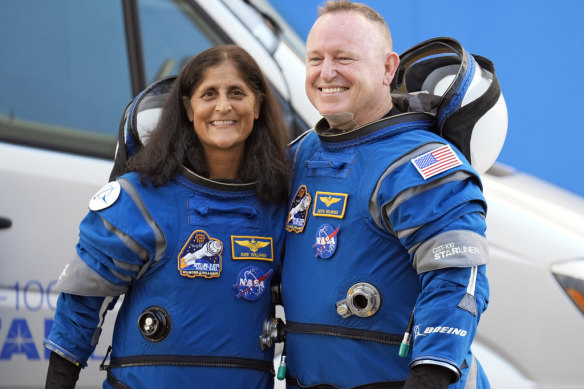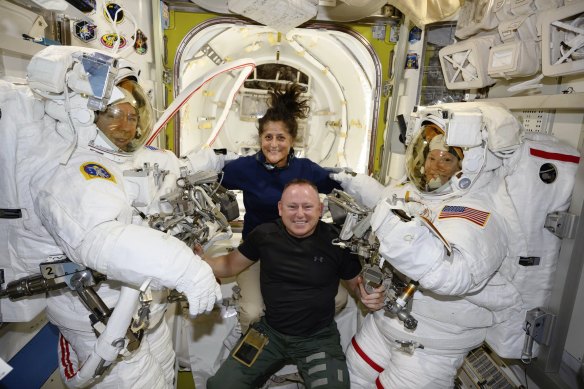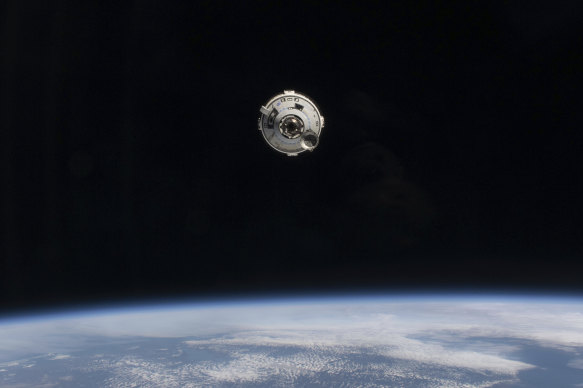This was published 5 months ago
They went to space for eight days, are now stuck indefinitely, but don’t call them ‘stranded’
By Kenneth Chang
If you go somewhere expecting an eight-day trip and end up not being able to leave for eight months, most people would consider that “stranded”.
That is what has happened to Suni Williams and Butch Wilmore, two NASA astronauts who travelled to the International Space Station in June aboard Boeing’s Starliner spacecraft. During the test flight, the propulsion system malfunctioned, and engineers are not certain it would bring the two astronauts back to Earth alive.

NASA astronauts Suni Williams and Butch Wilmore before take-off at Space Launch Complex 41 on June 5. Credit: AP
So, doesn’t that mean the astronauts are stranded?
Delian Asparouhov, a founder and the president of Varda Space Industries, which seeks to manufacture drugs and other materials in space, posted on the social platform X: “I don’t know about you, but if I got stuck at an airport for seven months longer than expected, that would definitely qualify as ‘stranded’.”
But for astronauts who spend their careers hoping to travel to space, extra time in orbit – now 10 weeks and counting – is not a nightmarish struggle for survival as it is for Matt Damon’s marooned astronaut character in the movie The Martian.
Indeed, it might be more like your boss asking if you would mind extending a short business trip to Paris by half a year.

Williams and Wilmore (centre) with Expedition 71 flight engineers Mike Barratt (left) and Tracy Dyson, aboard the International Space Station’s Quest airlock on June 24.Credit: AP
“Butch and I have been up here before, and it feels like coming home,” Williams, who has had two previous long stays on the space station, said during a news conference last month. “It’s great to be up here, so I’m not complaining.”
Whether Williams and Wilmore are stranded or not, NASA now faces a difficult decision within the next week or so about the safest way to bring them back to Earth.
If it decides the problems with Starliner’s propulsion system pose too great a risk, NASA will switch to a back-up plan, bringing the two astronauts home on Crew Dragon, a vehicle built by Boeing rival SpaceX.
That will lead to a juggling of astronaut assignments for the space station. The next Crew Dragon, scheduled to launch in late September, would take two astronauts to the space station instead of four, leaving two seats for Williams and Wilmore on the return trip around February.

The Boeing Starliner spacecraft with astronauts Butch Wilmore and Suni Williams aboard approaches the International Space Station.Credit: AP
All northern summer, NASA and Boeing officials have been reluctant to use the words, “stuck” and “stranded”, which would add another black mark to a spacecraft that has been delayed for years by technical setbacks.
“I think reporters use imprecise language to get viewers,” said Lori Garver, who was deputy administrator of NASA during the Obama administration. “We’re all used to that. I don’t think it’s worth being defensive about, but they’re also not really stranded.”
For one, though NASA and Boeing did say Starliner would spend at least eight days at the space station, officials say this is a test flight designed to uncover problems. Thus, they say, it is not a surprise that not everything has gone perfectly.
“I think we all knew that it was going to go longer than that,” said Mark Nappi, the Boeing official in charge of the Starliner program. “We didn’t spend a lot of time talking about how much longer, but I think it’s my regret that we didn’t just say, ‘We’re going to stay up there until we get everything done that we want to go do’.”
The reasons for the astronauts’ extended visit – or stranding, if you prefer – involves 28 thrusters known as the reaction control system that Starliner uses for manoeuvring. During its approach to the space station, five of them malfunctioned. Though four were revived, and Starliner safely docked, there remained concerns that they might fail again on the return trip.
Ground testing showed that the problem might have been caused by the expanding of a Teflon seal within the thrusters, constricting the flow of propellant.
But subsequent test firings of Starliner’s thrusters in orbit showed that the performance had returned to almost normal. That was puzzling because a distorted Teflon seal would not be expected to return to its original shape. That raised the possibility that something else was the cause of the thruster problems.
Joseph Fragola, an aerospace safety expert who has not worked on Starliner but who did work with similar thrusters on the lunar lander during the Apollo program in the 1970s, said an imbalance of the propellants could lead to a build-up of gunk within the thrusters. That, too, would explain the diminished performance of the thrusters, and the residue could later evaporate, explaining why the thrusters now work normally.
“I don’t know if that’s the problem they’re having, but it took us a long time to fix that problem,” Fragola said.
If that is an issue, it could pose a serious danger. The residue and an unbalanced mixture of propellants could set off an explosion, Fragola said.
NASA officials offer another reason to support their assertion that Williams and Wilmore aren’t truly stranded: They remain confident enough in Starliner that two astronauts would use it in case of an emergency evacuation of the space station.
That was not the case in December 2022, when the radiator of a Russian Soyuz capsule sprang a leak and all of the vehicle’s coolant floated into space. NASA astronaut Frank Rubio had travelled to the space station on the Soyuz, and NASA officials decided the damaged spacecraft was not safe enough for an emergency because temperatures inside during re-entry might grow fatally hot. At that time, a jury-rigged seat was added for Rubio in a Crew Dragon that was also docked at the space station.
Rubio was arguably stranded at the space station until Russia sent a replacement Soyuz. He had been scheduled to spend six months at the space station, but he ended up setting the record for the longest single stay in orbit by a US astronaut: 371 days.
The extended stays for Williams, Wilmore and Rubio may have been unplanned, but not uncomfortable, as plenty of supplies are brought up by cargo spacecraft.
That was not the case in 2003 for Don Pettit, an astronaut who is in Russia preparing for his fourth spaceflight, a launch to the space station scheduled for September 11. During his first spaceflight two decades ago, he was one of three astronauts on the space station when the space shuttle Columbia disintegrated during reentry.
Pettit, along with Ken Bowersox of NASA, who is a top NASA official overseeing Starliner’s plight and was then the commander of the ISS, and Nikolai Budarin, a Russian astronaut, were in no immediate danger.
But as the three crew members grappled with the deaths of seven NASA astronauts – their friends and colleagues – Pettit and Bowersox also quickly realised that the shuttle Atlantis, which was to pick them up the following month, was not arriving anytime soon. They began rationing supplies.
“We were immediately on a water shortage and a food shortage and a clothing shortage, and we extended the best we could these supplies,” Pettit said.
In a NASA interview in 2015, Pettit said there were more than enough supplies there. But no one knew how long the shuttles would remain grounded.
“It’s like you’re sitting on a mountain of food and clothing, and you’re starting to ration these things out, not because you need to for your mission, but you’re doing that to extend other people’s missions,” Pettit said.
There are no washing machines in space, so clothes are worn for a few days, then used as rags, then thrown out. Pettit said the astronauts began wearing their clothing longer than planned.
“The indicator that it was time to change your underwear would be when you started to get a rash around your waist,” Pettit said.
Pettit and his crewmates finally returned to Earth in May 2003 on a Russian Soyuz spacecraft, three months later than planned.
This article originally appeared in The New York Times.
Get a note directly from our foreign correspondents on what’s making headlines around the world. Sign up for the weekly What in the World newsletter here.